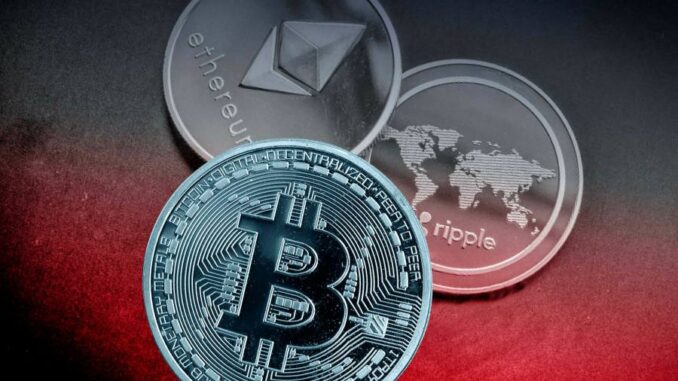
This article is an on-site version of our Unhedged newsletter. Sign up here to get the newsletter sent straight to your inbox every weekday
Good morning. Nice day yesterday. Stocks up, bonds down. Everything is back to normal. The landing will be soft. Lions will lie down with lambs. Maybe. Email us: robert.armstrong@ft.com and ethan.wu@ft.com.
The crypto crisis gets its hero arc
Here is a drastically simplified account of what’s happened in crypto since last we checked in.
A crypto bank, Celsius, with huge maturity mismatches and a meagre equity cushion caved in as token prices fell and deposits fled. A hedge fund, Three Arrows Capital, had exposure to seemingly every bad bet in crypto, including the failed stablecoin TerraUSD. It’s bankrupt. And a bunch of other crypto companies, including Voyager and BlockFi, who had loaned to 3AC, or who are witnessing scared investors pull out money, are flailing.
It all feels a tad predictable. What has been more surprising is the role of Sam Bankman-Fried, known as SBF, the 30-year-old CEO of crypto exchange FTX. He has rushed into the breach with emergency loans and buyouts, and said on Wednesday that he could muster “a few billion” more if needed. Some are calling him crypto’s central bank (one analyst suggests Sam Bankman-Fed) or comparing him to John Pierpont Morgan. SBF sounds like a real captain of industry:
We have a responsibility to seriously consider stepping in, even if it is at a loss to ourselves, to stem contagion.
Here’s what he has done lately:
He acquired Bitvo, a Canadian crypto trading platform, for an undisclosed amount.
He gave BlockFi, a crypto trading and lending service, a $400mn credit facility in return for a purchase option to buy it for up to $240mn.
He provided Voyager, another crypto lender, with a $485mn credit facility, $75mn of which it tapped before going bankrupt.
One can haggle over whether the John Pierpont Morgan analogy fits. SBF has an obvious interest in stemming contagion and keeping the crypto economy afloat. But the hard fact is, he is not, and cannot be, much of a backstop.
Bitvo looks like a standard acquisition, part of FTX’s ambition to expand to other markets and jurisdictions. So does the BlockFi deal, with a fat discount (the company was going for a $5bn valuation a year ago). Voyager is more interesting. Bankruptcy filings released on Wednesday showed an SBF-linked company was at once a creditor, debtor and shareholder of Voyager.
“The Voyager story makes sense if it’s just self-protection,” one noted crypto executive told Unhedged. “The BlockFi story makes sense [if it’s just] buying a distressed asset on the cheap. I don’t buy the ‘preventing systemic risk’ story one bit. Sam is in it to make money.”
But even if this is just the beginning, and SBF did end up spending billions propping up crypto groups, that can’t stop dollars fleeing. The problem is that crypto is worth $950bn, and his net worth is perhaps 1 per cent of that. Even if he spent his last penny, and his companies’ too, he could not stop a proper rush for the exits. As the writer Frances Coppola argued in Coindesk recently:
There [isn’t] enough [dollar liquidity] to enable everyone to cash out into real dollars . . . So, in effect, the entire crypto industry is fractionally reserved . . .
When everyone is trying to cash out cryptocurrencies into increasingly scarce dollars, cryptocurrency prices rapidly fall to the level at which there are sufficient dollars in the system for everyone to be able to cash out . . .
If tighter money is here to stay, as many expect, then continuing dollar scarcity will make it impossible for crypto to rise again as it has before.
If anything, SBF’s greatest impact could be purely psychological — inspiring confidence with a flurry of high-profile deals. Maybe that coaxes money back in. Crypto, after all, is based on faith. (Ethan Wu)
China pours on the stimulus
A week or so ago, writing about the bounce in Chinese stocks, we suggested that Beijing would push aggressive new stimulus programmes as its Covid lockdowns began to ease. It was not a risky prediction, and it has come true, in a big way, in a hurry. This is from the South China Morning Post, on Wednesday:
Local governments sold a record Rmb1.94tn ($289bn) worth of bonds last month, representing a year-on-year increase of 143 per cent, according to Great Wall Securities, as China once again turned to its old playbook of driving up growth through public investment. This topped the previous record of Rmb1.3tn in May 2020.
The May bonanza brings total local issuance for the year to more than Rmb5tn, the SCMP reports. Some Rmb3.4tn of this is special purpose bonds, which funds infrastructure. That is 93 per cent of the central government’s annual quota for such bonds. So, presumably, there will be much lower issuance of special purpose bonds in the second half. Oh, wait. From Bloomberg, yesterday:
China’s Ministry of Finance is considering allowing local governments to sell Rmb1.5tn ($220bn) of special bonds in the second half of this year, an unprecedented acceleration of infrastructure funding aimed at shoring up the country’s beleaguered economy . . . Previously local governments didn’t start selling the debt until January 1, when the new budget year begins.
Nor is that all. This, from Caixin Global on Monday, sums up two other recently-announced stimulus measures:
The China Development Bank (CDB), the country’s largest policy lender by assets, will fund the majority of Beijing’s latest Rmb300bn ($45bn) infrastructure stimulus, sources with knowledge of the matter told Caixin . . .
The State Council, China’s cabinet, announced the Rmb300bn fundraising on Thursday, saying that the funds would serve as capital for major infrastructure projects or as bridge financing for projects funded by local governments’ special-purpose bonds . . .
The Rmb300bn stimulus measure comes in addition to an Rmb800bn increase in the three policy banks’ lending quota, also to support infrastructure investment, announced at a State Council executive meeting on June 1.
Setting aside the record infrastructure bond sales already completed, the projected above-quota infrastructure bond sales; the development banks’ infrastructure fund; and those banks’ increased lending quotas come to Rmb2.6tn — something over 2 per cent of gross domestic product. That is a big short-term stimulus even if, as almost everyone assumes, the long-term returns on the investments will be low.
Here is the odd bit. Even as the government mandates the creation of credit at a heroic scale, it is drawing liquidity out of the banking system. Here is Bloomberg again:
China’s central bank looks set to withdraw cash from the financial system in a sign that it’s moving towards normalising monetary policy as major global peers are forcefully raising interest rates.
The People’s Bank of China slashed its daily short-term liquidity operation to Rmb3bn ($447mn) this week, the smallest amount since January 2021 . . .
“The PBoC is shifting its monetary policy from a crisis mode to a normalisation,” Ming Ming, chief economist at Citic Securities, wrote in a note . . .
It looks a little funny to take your monetary policy out of emergency mode (by buying fewer short-term bonds) even as your credit stimulus programme goes into super-duper-emergency mode. I could not find a crisp interpretation of what the Chinese authorities are going for here. The Bloomberg article takes a shot at it:
The smaller-than-expected [short-term bond-buying programme] may be the central bank’s attempt to introduce volatility and reduce financial leveraging in the bond market, Goldman Sachs Group strategists including Xinquan Chen wrote in a note this week. Excessively low interest rates could also add to financial risks via increasing arbitrage activity, where corporates may borrow funds for redeposit rather than real investment, they wrote.
So the government wants to tamp down speculative/arbitrage activity by increasing the cost of short-term finance, at the same time as it stimulates the real economy by jamming credit into it. But further debt-funded infrastructure spending in a country that already, arguably, has too much infrastructure carries speculative risks of its own. Send an email if you understand this better than I do.
One good read
After Bojo.
Recommended newsletters for you
Due Diligence — Top stories from the world of corporate finance. Sign up here
Swamp Notes — Expert insight on the intersection of money and power in US politics. Sign up here






Be the first to comment